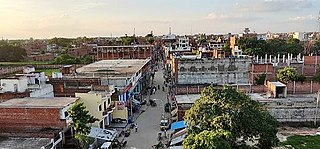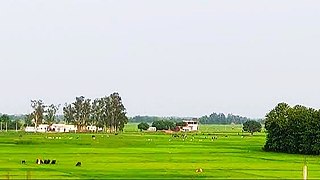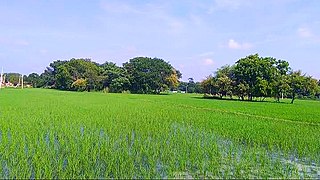
Rohillas are a community of Pashtun heritage, historically found in Rohilkhand, a region in the state of Uttar Pradesh, India. It forms the largest Pashtun diaspora community in India, and has given its name to the Rohilkhand region. The Rohilla military chiefs settled in this region of northern India in the 1720s, the first of whom was Ali Mohammed Khan.

Ghazipur district is a district of Uttar Pradesh state in northern India. The city of Ghazipur is the district headquarters. The district is part of Varanasi Division. The region of Ghazipur is famous mainly for the production of its unique rose-scented Spray called Gulab Jal, and for the tomb of the Governor General of British India, Lord Cornwallis, who died here. His tomb is situated in Western part of City, and is conserved by Archaeological Survey of India.
Zamania is a town in the Indian state of Uttar Pradesh. Its municipal council is subordinate to the Ghazipur District. It is also the administrative head of Zamania tehsil,. It is also a very historical town, it derives its name from Ali Quli Khan Zaman, who was also known as Khan Zaman or Zaman Khan, he was a governor of Jaunpur, and Ghazipur during the time of Akbar.
Khan-e Jehan Nawab Qaim Khan Shaheed who was the son of Raja Motay Rao Chauhan, the ruler of Dorayra or Dadrewa. The first progenitor of Qaimkhanis was Karamchand born in the family of Moterao of Chauhan clan, the ruler of Dadrewa. Firuz Shah Tughluq converted him to Islam and named him Qaimkhan. Thus his descendants were called Qaimkhani. He embraced Islam along with his brothers, Nawab Zainuddin Khan and Nawab Jabaruddin Khan, in the times of Sultan Feroz Shah. Descendants of Nawab Zainuddin Khan and Nawab Jabaruddin Khan are also 'Qaim Khanis'.

Dildarnagar Kamsar is a pargana (region) and a mashra comprising 34 settlements located around the Karamnasa River in the Ghazipur district of Uttar Pradesh and the Kaimur district of Bihar, India. Of these, 18 mouzas are the primary settlements. It is a prominent settlement of Khanzadas, also known as Kamsari Pathans, as well as Afghan Pathans, primarily of the Niazi and Yusufzai clans. The original name of the region was Kamsar, but due to close and historical ties with the family of Bara Pathans, the region is often referred to as Kamsar-O-Bar. It was established in 1542 by Raja Narhar Khan.

Usia is a village in Kamsaar, Uttar Pradesh, India. It is located southeast of Ghazipur and east of Dildarnagar, near the Bihar State border. The village has a population of 24,786 residents living in 3,471 households. Usia is approximately 7 km from Dildarnagar. Around 8500 Kamsar Pathans lived here as of 2011.
Amir Chak is a village in Kamsaar in the Indian state of Uttar Pradesh.
Rakasaha is a village in Kamsaar in the Indian state of Uttar Pradesh. Almost 6500 Kamsaar Pathans(NAWABS) lived in the village as of 2011.

Kurrah or Tajpur Kurrah is a village in Dildarnagar Kamsar region of Zamania tehsil in Ghazipur district. It is avillage of pathan Kamsaari pathans in the Indian state of Uttar Pradesh. Almost 3900 Kamsaar Pathans lived in the village as of 2011.

Gorasara is a village located in Dildarnagar Kamsar, Uttar Pradesh, India. Goarasara village was established by Bhikham Khan, son of Fateh Bahadur Khan, and great great grand son of Narhar Khan.
Bahuara is a village in Kamsaar in the Indian state of Uttar Pradesh. Bahuara is a village with a population of almost 5000. It is surrounded by others Kamsar villages. Bahuara is well connected with the town of Dildarnagar which is hardly 2-3 kilometres away from the village. People of Bahuara are scattered throughout the world. Ancestrally, the people of bahuara have been a land-owning (Zamindar) community divided into two colonies Westside & Eastside. Neighbouring villages are Rakhsaha, Dildarnagar, and others.
Mania is a village in Kamsaar in the Indian state of Uttar Pradesh. It is located in Seorai Tehsil in the Ghazipur district. It is situated 22 km (14 mi) from the sub-district headquarters Seorai and from the district headquarters Ghazipur. Its total area is 428.68 hectares and a total population of 5736. Mania village was established in the early 1590 a.d. by Khizir Khan, who was a grandson of Narhar Khan.

Chitarkoni is a village in Kamsaar in the Indian state of Uttar Pradesh.
Fufuao or Rampur Phuphuaon is a village in Dildarnagar Kamsar in the Indian state of Uttar Pradesh.
Seorai is a village of Dildarnagar Kamsar, and also serve as the headquarters of SeoraiTahsil in region of Ghazipur District of Uttar Pradesh, India. The Seorai tehsil was made a tehsil of the Ghazipur District in year 2016. It consists of 142 villages and one town. Seorai main village has a total area of 878.02 hectares and a population of 20000 but its total area is 1,082.83 hectares and a population of 20,530 which also includes Bhadaura. Seorai tehsil has the total area of 366.62 km2 (141.55 sq mi). Seorai also served as the capital of Kamsaar estate from late 1500s to mid 1600s.
Nawali is a village in Seorai tehsil of Ghazipur District, Uttar Pradesh, India.
Kabirpur also known as Rohura is a village in Zamania tehsil of Ghazipur District Uttar Pradesh, India. It was a part of Dewaitha but later was made another village in 1953. Kabirpur was established by Raja Kabir Khan.
Asaichandpur, also known as Ashiya Chand Pur and previously known as Alipur, is a village in Zamania Tehsil in the Ghazipur District of Uttar Pradesh, India. The land where Asaichandpur is located was owned by the descendants of Mahmud Khan of Rasulpur, the eldest son of Daud Khan. Asaichandpurn was once a small settlement of farmers. The village's population increased to more than 1,200 by 2011.
Jalalpur is a village located in Zamania tehsil of Ghazipur district of Uttar Pradesh, India. The village was originally a part of Dewaitha but was later made into a separate village. The village derived its name from Jalaluddin Khan who was a child of Wasil Khan. Wasil Khan was referred to as the most charitable and helping person of Dewaitha and nearby villages. The name Jalalpur was kept in honour of Wasil Khan who was father of Jalaluddin Khan. It is said that Wasil Khan and his brothers bought land and after some year donated almost 150 acres of land to poor people for the establishment of this village so the people named the village after Wasil Khan's son, Jalaluddin Khan. Jalaluddin Khan also served as the Pradhan of Dewaitha. The village of Jalalpur was previously known as Babhanpura, a large population of Brhaman family's also here who shifted here in 1950s and bought land from poor families who went to the cities. Much of the land donated by Wasil Khan and his brother was owned by Braahman and Rajput families of nearby villages.
Dewaitha is a village of Dildarnagar Kamsar,in Zamania tehsil of Ghazipur, India, located on the banks of the Karmanasa River and it's tributary Eknaiya, The village had a population of 7,104 as of the 2011 Census of India. The place is inhabited by Kamsar Pathans..








